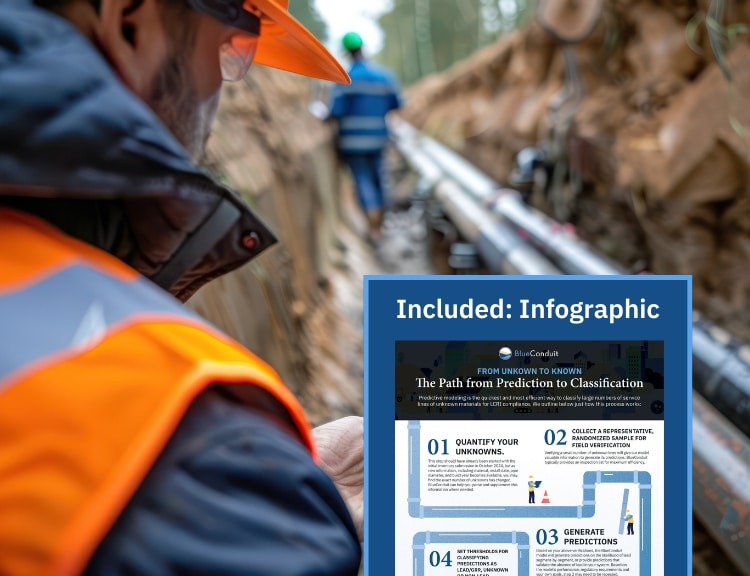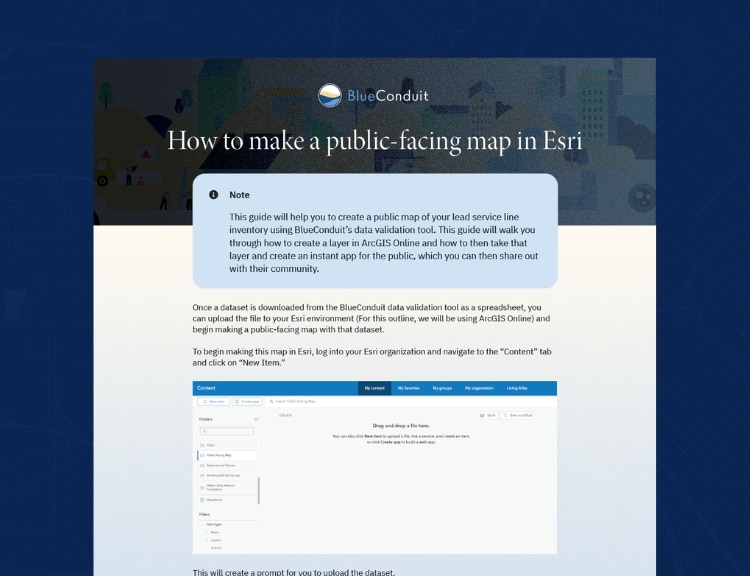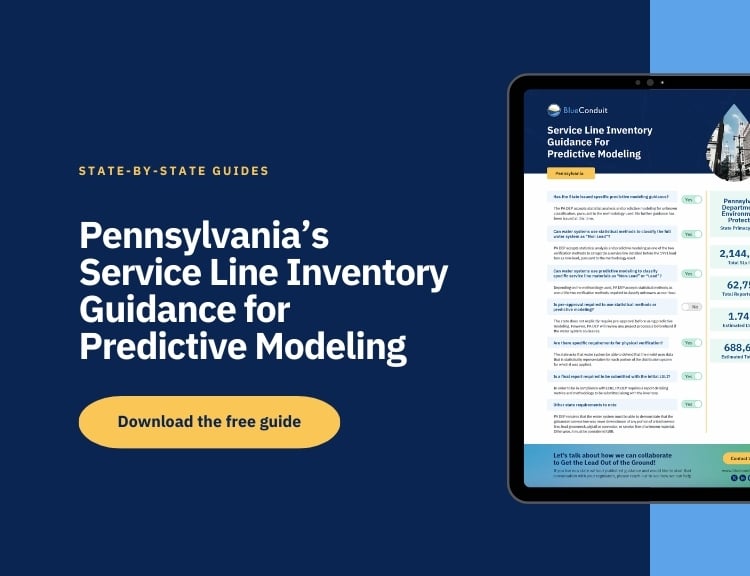In recent weeks, the Federal Government has identified various funding opportunities for water infrastructure projects with an emphasis on lead abatement. BlueConduit can support your effort to access federal funding for lead service line inventory and replacement.
The following federal programs are in various stages of review and approval. Updates on their status are available below.
Latest update: January 5, 2023
Funding Programs
The bipartisan Infrastructure Investment and Jobs Act funding is divided into seven major programs:
(1) the Drinking Water and Clean Water State Revolving Funds ($23.43 billion) provide “below market rate” loans and grants to fund water infrastructure projects that protect public health and environment.
(2) Lead Service Lines ($15 billion) program is part of the Lead Pipe and Paint Action Plan
(3) PFAS and Emerging Contaminants ($10 billion) provides funding for states and water utilities to treat PFAS or any pollutant identified by the EPA Administrator as a contaminant of emerging concern.
(4) Indian Water Rights ($2.5 billion) satisfies Federal obligations under Indian water rights settlements.
(5) Indian Health Service Water and Sewer ($1.8 billion) provides funds for the provision of domestic and community sanitation facilities for Tribal communities.
(6) Water and Sewer Tax ($1.25 billion) creates a tax credit for any “contribution in aid of construction” or any other contribution for purposes of water storage.
(7) Rural Water ($1 billion) invests in water infrastructure projects in rural communities.
(8) Western Water ($7.1 billion) funds projects associated with water infrastructure, treatment, management, and maintenance.
The 2021 American Rescue Plan, the $1.9 trillion federal coronavirus relief package, includes $350 billion in emergency funding for state, local, territorial, and Tribal governments. Known as the State and Local Fiscal Recovery Fund, this program enables governments to address the revenue losses they are facing because of the pandemic and provide funding to support economic recovery efforts in their region. The Recovery Fund specifically directs governments to seek funding for investment in water infrastructure to remove harmful lead contaminants from drinking water and promote the health and well-being of their citizens.
Funds do not have to be obligated until December 31, 2024, and unexpended funds are not subject to recapture or return until December 31, 2026.
Read the Day One Project white paper for a playbook on efficiently removing lead.
Read our blog post about the Day One Project.
The Environmental Protection Agency (EPA) announced $6.5 billion in new funding for water infrastructure projects under the WIFIA program. This new allocation of resources is meant to advance the following priorities:
- Supporting economically distressed communities
- Protecting water infrastructure against the impacts of climate change
- Reducing exposure to lead and addressing emergency contaminants
- Updating aging infrastructure
- Implementing new or innovative approaches including cyber security and green infrastructure
The State infrastructure financing authority WIFIA (SWIFIA) program, authorized by Congress in the America’s Water Infrastructure Act (AWIA) of 2018, is a loan program exclusively for State infrastructure financing authority borrowers.
This year, the EPA is accepting letters of interest on a rolling basis starting September 6 and will continue to accept letters of interest until the earlier of
- the commitment of all available funding made available for that round, or
- publication of a subsequent notice canceling or overriding the current NOFA.
A rolling selection process allows EPA to provide year-round access to WIFIA funding and quicker selection decisions to prospective borrowers.
The EPA’s Small Business Innovation Research (SBIR) Program is welcoming proposals from small businesses focused on developing innovative environmental technologies related to the following topics: clean and safe water, air quality, homeland security, safer chemicals, and risk assessment. The next EPA SBIR solicitations are open, which can be submitted via FedConnect. You can find more information on the EPA website.
An EPA-administered federal-state partnership to provide financial support for drinking water and wastewater infrastructure projects as well as other water quality related projects (e.g., lead sampling in schools and childcare facilities). The DWSRF is structured as a federal-state partnership through which a permanent drinking water infrastructure revolving loan fund has been created in every state. (Puerto Rico is defined as a state for purposes of the DWSRF.) The federal government provides capitalization grants to states. States provide a 20% match for those grants.
The 2016 WIIN grant program offers funding for three categories. The first establishes the Small, Underserved, and Disadvantaged Communities Grant Program to provide grants to eligible entities for use in carrying out projects and activities the primary purposes of which are to assist public water systems in meeting Safe Drinking Water Act requirements. The second establishes the Reduction in Lead Exposure via Drinking Water Grant Program emphasizing the reduction of lead in drinking water in disadvantaged communities. facilities. The third, establishes the “Lead Testing in School and Child Care Program Drinking Water” grant to award funding to states and tribes to “assist local and tribal educational agencies in voluntary testing for lead contamination in drinking water at schools and childcare programs.
As of January 2023, the EPA has closed its FY22 Request for Applications under the WIIN Reducing Lead in Drinking Water grant. More information for FY23 will be available on grants.gov.
Distributed by HUD, grant funding is provided for projects that specifically benefit communities with higher proportions of low and moderate-income residents who are often exposed to conditions that negatively impact their health or well-being (e.g., LCLs), including construction of public facilities and improvements, such as water and sewer facilities, streets, neighborhood centers, and the conversion of school buildings.
The USDA Rural Development Water and Environmental Program fund provides funding for the construction of water and waste facilities in rural communities and is proud to be the only Federal program exclusively focused on rural water and waste infrastructure needs of rural communities with populations of 10,000 or less.
With overwhelming bipartisan support, the Senate has passed the DWWIA. This legislation, if also approved by the House of Representatives, would invest $35 billion into EPA loan and grant programs with $710 million specifically designated for improving access to safe, clean drinking water. The $710 million will help communities address the public health crisis of lead contamination in drinking water by:
- Increasing the Lead Reduction Grant program to $100 million annually
- Increasing the Voluntary Lead Testing in Schools program to $50 million annually by 2026, for a total investment of $200 million
- Expanding the Small and Disadvantaged Community Grant Program to allow grant funds to be used for the purchase of filters and filtration systems
- Creating a pilot program for municipalities to assess the effectiveness of lead mapping as a tool to identify and replace lead service lines, authorized at $10 million
- Reauthorizing an EPA emergency fund at $35 million annually that can be used to address public health emergencies caused by lead in drinking water





